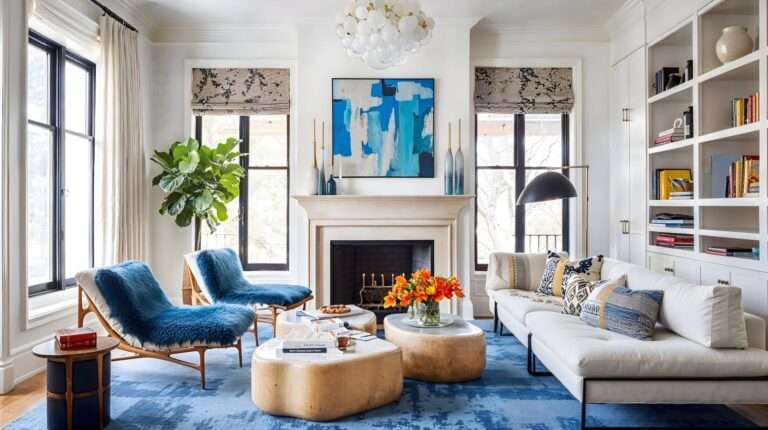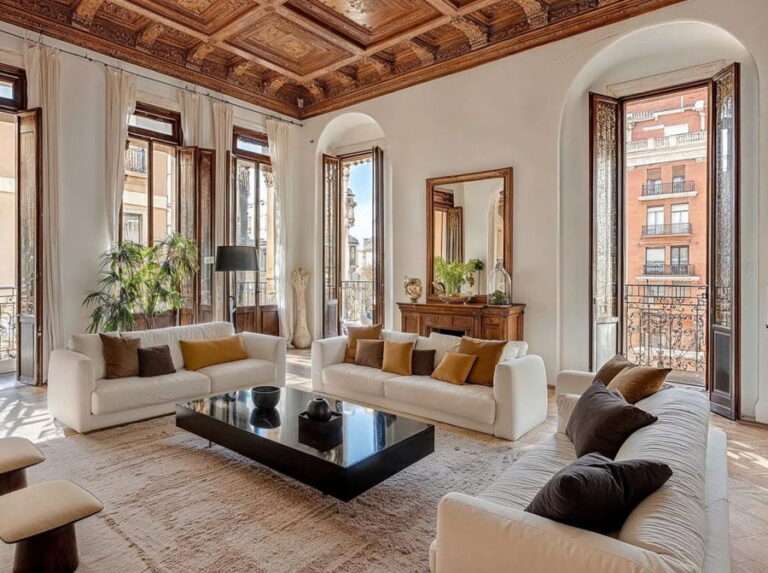The rise of artificial intelligence (AI) has been nothing short of revolutionary, and it seems that no commercial sector is immune to the seductive power of automation. But what about creative industries, such as interior design? Can AI replace interior designers and the human touch that has shaped some of the most iconic and beautiful spaces throughout history?
While AI is undeniably changing the way we approach design, the general consensus among industry professionals is a resounding “no”—AI cannot fully replace interior designers. Let’s see why this is the case and how AI can still be a powerful tool that powers up, rather than substitutes, the work of talented designers.
Why AI Can’t Replace Interior Designers
AI is undoubtedly a powerful tool that can support many processes behind the scene. However, the essence of interior design is the complex interaction between the client and the designer, which makes the resulting spaces truly our own. It’s less about creating a pretty room, and more about understanding personal preferences, interpreting emotions, applying psychology, and combining lifestyles with creative visions. This field remains uniquely human.
On the other hand, AI can assist designers by speeding up the process. It can save hours of manual work by providing data-driven insights and helping with visualization.
Pro Tip: Whether you’re using AI or a real designer, knowing your style is key. Not sure what that is? Try our Free Interior Design Style Quiz to discover your ideal style today!
1. Real Design is Personal
Interior design is deeply rooted in personal expression and subjective taste. Every client has their own unique preferences and practical and lifestyle needs. While AI can generate room layouts based on data and partially decipher the client’s vision for their space, it lacks the nuanced understanding of personal stories that a designer brings to the table.
Think for a moment about the idea of a cozy living room, for example. What does “cozy” mean to you? Is it a hygge interior filled with fuzzy throws and candles? Or perhaps something more in the Hamptons style, comfortable yet carefully curated?
As simple as it sounds, creating a cozy room requires much more than arranging pretty furniture; it involves understanding the client’s family dynamics, memories, and values. A cozy space for a single, young, active professional will hardly meet the needs of a family with two pets. AI might suggest a layout based on popular trends or algorithmic preferences, but it can’t replicate the empathy and intuition that an interior designer uses to craft a personalized space.
2. Complexity of Human Interaction
Interior design is a collaborative process. It involves not only understanding the client’s needs but also communicating, problem-solving, and adjusting designs based on feedback. A successful interior designer will grasp the style, solve specific practical challenges, and offer expert guidance—all with the consideration of the client’s budget.
Now, as for what AI can do: it’s able to generate automated design suggestions. What it cannot do is engage in meaningful back-and-forth dialogue with a client. When you change your mind about a design, an interior designer can quickly pivot, understanding the full impact of that decision, from emotional to economic. They will warn you about the risk or consequences and suggest better (for you) alternatives if needed. AI, however, has no real capacity to adapt to changes in that way. It can simulate the comprehension, but it won’t offer a tailored solution.
3. Creative Vision and Artistic Interpretation
The essence of interior design lies in creativity—in making decisions that not only meet functional requirements but also tell a personal story. Interior designers think outside the box, drawing from years of experience, culture, and artistry to create something unique. They interpret styles and balance all design elements in ways that can evoke certain emotions or atmospheres.
AI can analyze data and generate options based on it. It will suggest trendy designs, but don’t expect it to deliver the artistic vision and originality that come from the human mind. The real meaning comes from context, and the genuine context is something only a skilled designer can provide.
4. Hands-On Experience and Implementation
Interior designers stay inside the project from the preliminary concept to the day furniture is settled into place. Some oversee the entire process, which includes managing contractors and suppliers. Your designer can coordinate with masons as plaster cures, walk suppliers through site access, or resolve adjustments when a beam span, tile batch, or finish shifts in tone.
This hands-on experience ensures flawless implementation of the design—all logistics are accounted for, and the project stays on track.
Meanwhile, AI can assist with tasks like product recommendations, but it cannot physically oversee the process of bringing a design to life. It won’t stand in the courtyard to judge how morning light falls on a plaster curve or decide with a builder how much deeper a niche should be cut. The attention to detail required in sourcing materials, managing timelines, and handling unexpected obstacles is something only a human designer can handle effectively.
5. Cultural Sensitivity and Context
Human professionals carry knowledge of how materials and motifs, as well as spatial traditions, speak within a given culture or the style direction it conceived. They know when a pattern carries regional meaning or whether a textile belongs to a particular lineage. A designer working inside Spanish revival interiors, for instance, reads the meaning in a Talavera tile and can recognize the craft embedded in hand-forged iron.
This is one of the fields where AI won’t be able to replace interior designers for a very long time—if ever. These decisions ask for awareness of region and history on a subtlety level unattainable to automated selection. Cultural knowledge comes through people who have lived with the work, walked the spaces, listened to the stories that surround them, and have the power to sense the feelings in the background.
6. Lack of Physical Accuracy and Real-World Understanding
One of the key limitations of AI in interior design is its notorious lack of accuracy when it comes to physical aspects of a space. Generated digital layouts and models rarely account for the real-world dynamics of a room, such as precise dimensions, spacing, and the flow of movement. Overlooking the distance between furniture pieces or how elements within an interior interact results in impractical layouts or wasted space. And yet, all these details are crucial in a functional, comfortable environment.
Interior designers build their work from accurate measurements. Their on-the-ground experience ensures that furniture fits appropriately and that the room functions as intended.
How AI Can Help, But Not Replace Interior Designers
In summary, AI cannot replicate the artistry, expertise, or cultural sensitivity that human designers bring to the table. Yet it doesn’t mean this kind of algorithm is useless in the industry. Rather than replacing interior designers, AI is best seen as a support tool that helps designers deliver even more optimized or personalized results to their clients. Here’s how.
1. Speeding Up the Design Process
On most projects, the first weeks disappear into groundwork. AI tools collapse that timeline. With its help, a single site survey can be scanned and converted into a working model, with alternative furniture plans or partition schemes generated before the team leaves the building. Instead of redrawing the same shell to test options, the designer can walk through a sequence of viable layouts in real time and start refining proportions on the spot.
The same applies to sourcing. A tile specification that once required hours of flipping through catalogs now runs through AI filters that sort by size, glaze, lead time, even country of origin. Within minutes, the algorithm delivers a shortlist that respects both supply constraints and design intent. Lighting studies can also be run as fast simulations to show how plaster, timber, or tile will read at different hours. The acceleration frees the designer from mechanical repetition, so more time is spent making the judgments that carry the project forward.
2. Data-Driven Insights
AI excels at analyzing large amounts of data, which can be incredibly helpful for interior designers. While it may not comprehend the client preferences on an abstract human level, it can scrutinize trends and market data to provide designers with insights into what’s popular or what might appeal to a certain demographic.
For instance, if a designer is working on a project for a tech-savvy, modern family, AI could suggest a selection of accessories based on statistical data. The designer, in return, makes more informed decisions and stays ahead of trends without relying solely on their intuition.
3. Virtual Reality and Augmented Reality
AI strengthens VR and AR by filling them with content that designers can actually use. Instead of manually modeling every beam or arch, the system can extrapolate from measurements and produce a structure that reads with correct scale and proportion. A traditional ceiling with timber spans, for example, can be generated instantly at the right depth and spacing, then dropped into a headset view for both designer and client to walk beneath.
Material testing gains the same acceleration. AI can map tile patterns across stair risers or fireplace surrounds, adjusting for grout width and curvature in real time, so a designer can check how the geometry feels when viewed at eye level. In short, these tools don’t make choices, but they remove guesswork from the preview stage.
4. Automating Administrative Tasks
Design work often slows down when information is scattered across the chain. AI can gather those fragments and return them in a format that a designer can act on quickly. A shipment delay shows up the moment the supplier updates their system, and the alert arrives before the schedule is disrupted. Invoices from multiple vendors can be read, sorted, and organized into running totals without anyone re-entering line items.
An AI assistant can quickly find and highlight all the important messages or inputs from the client, so that no important detail escapes the designer’s attention. It also compares calendars, purchase orders, and delivery notes, then warns when tasks will collide.
Curious what happens when AI meets top interior designers??
At Decorilla, we blend human creativity with AI efficiency—bringing you smarter, faster, and more personalized design. Book your Free Online Interior Design Consultation to get started today!





